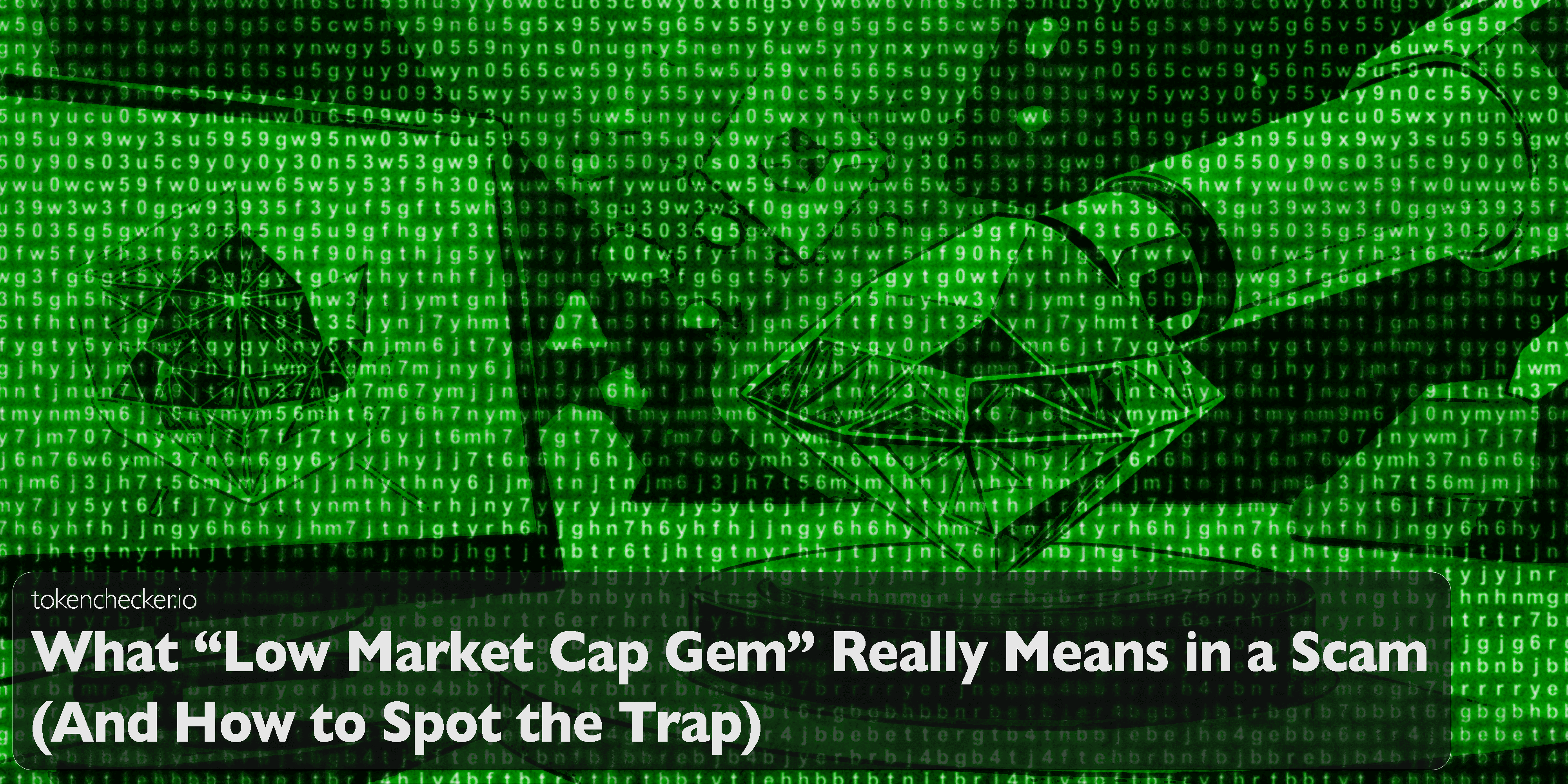
What “Low Market Cap Gem” Really Means in a Scam (And How to Spot the Trap)
The phrase “low market cap gem” is pure bait. It sounds like opportunity. It feels like the holy grail of early investing. But in the fast-moving chaos of crypto, it’s also the cover scammers use to lure you into low-liquidity, high-risk traps.
The problem isn’t the idea itself—some low-cap tokens are promising early-stage projects. But the narrative has been hijacked. Scammers now build fake tokens that look like gems but are designed to implode. This article breaks down how the scam version of a “gem” operates, why people fall for it, and how tokenchecker.io helps you decode the illusion.
Why “Low Market Cap” Sounds So Good
At a glance, low-cap assets seem like smart plays. They’re cheap. They’re early. And they have “room to grow.” This often triggers intense FOMO among investors.
Compared to established tokens like BTC or ETH, a coin with a $500k market cap seems like a better bet for explosive gains. And in bull markets, some do moon. But the same small size that offers upside also makes them incredibly easy to manipulate.
Here’s why:
- Low liquidity = big price jumps on small trades
- Few holders = whales can control supply
- Anonymity = devs can vanish with no trace
It’s a breeding ground for scams. And scammers know exactly how to make their “gem” look irresistible.
How Scammers Weaponize the “Gem” Narrative
1. Fake Undervalued Projects
They create a token with fake tokenomics, claim it’s “early,” and shill it on Telegram and Twitter. The hook? “Everyone’s sleeping on this one.” But the low cap is by design—it’s not a gem. It’s a trap.
2. Pump-and-Dump Hype
Small supply. Cheap entry. Loud promotion. They pump the token with fake volume, ride the hype, and dump on new buyers. Then? Radio silence. This is a common tactic in Telegram pump groups.
3. Locked Liquidity Theater
They claim LP is “locked,” but it’s short-term or fake. Once the token gets traction, they pull the liquidity and vanish. It looked safe until it wasn’t.
4. Mint and Sell Functions
The smart contract has hidden mint logic. Devs can create new supply anytime. You think you’re early until the price tanks from dilution.
5. Fake Social Signals
Bought Twitter followers. Fake Discord engagement. Influencer shills. It all looks legit. But it’s all noise.
Why This Scam Works So Well
Because it plays on two core emotions:
- Greed — “This could be my 100x”
- FOMO — “If I don’t buy now, I’ll miss it”
And it taps into hope. You want to believe it’s a secret opportunity others haven’t found. That emotional high makes you skip the research. And that’s where the losses happen.
Red Flags to Watch For in “Gem” Scams
- Anonymous dev team with no track record
- No audit or unverifiable audit claim
- Copycat whitepaper or generic roadmap
- Contract has mint, blacklist, or ownership toggle functions
- Liquidity either unlocked or locked for only a few days
- Same 3 wallets doing all the buys
- No real community—just hype bots
- Influencers calling it a gem… before it even launches
Real gems usually don’t need to scream “hidden gem” at you. Their work speaks louder than their marketing.
Case Examples
- SQUID Token: Looked like a legit tie-in. Couldn’t sell. Price hit $2,800 then dropped to zero.
- SnowdogDAO: Massive dump after insiders pulled liquidity. Retail investors couldn’t exit.
- SaveTheKids: Promoted by influencers, dumped by the dev wallet. Reputation wrecked, funds lost.
These weren’t just technical failures. They were emotional setups.
tokenchecker.io: Your Gem Reality Check
Before you touch a “low cap gem,” run it through tokenchecker.io. You’ll know in seconds whether it’s a real project or a disguised rug.
Key features:
- Originality Detection: Flags copy-pasted token names across chains
- Liquidity Lock Overview: Tells you if liquidity is locked, for how long, and who holds it
- Contract Analysis: Detects minting, honeypot logic, ownership toggles, and rug potential
- Creator Wallet Tracking: Shows if the dev is selling
- Top Holder Breakdown: Reveals if a few wallets control the supply
- Sniper & Bundle Detection: Finds if bots or insiders are gaming the chart
Hype is cheap. Data is not. tokenchecker.io helps you cut through the noise.
Final Thoughts
Not every low market cap token is a scam. But when you hear “hidden gem,” your first reaction should be skepticism—not excitement.
If it really is early and undervalued, the contract will prove it. The liquidity will back it. The team will stand behind it. And the community will grow naturally.
Don’t let dreams of a 100x make you ignore the 10 red flags.
Use tools. Ask questions. Run the address through tokenchecker.io. If the data doesn’t check out, it’s not a gem—it’s bait.